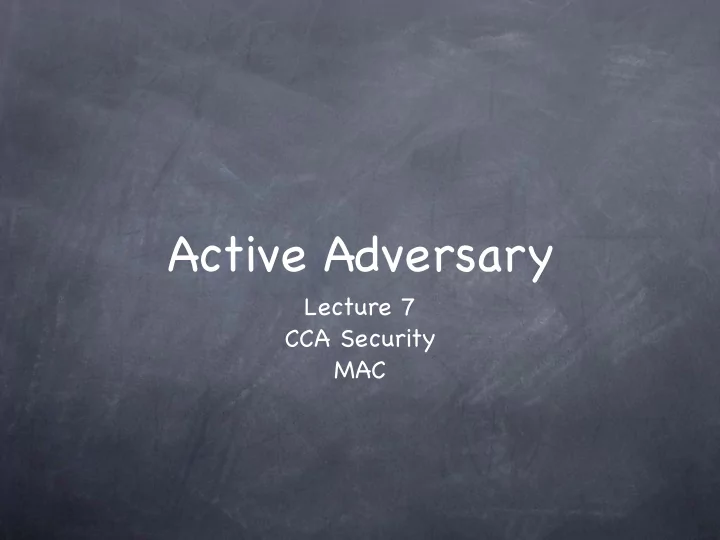

Active Adversary Lecture 7 CCA Security MAC
Active Adversary An active adversary can inject messages into the channel Eve can send ciphertexts to Bob and get them decrypted Chosen Ciphertext Attack (CCA) If Bob decrypts all ciphertexts for Eve, no security possible What can Bob do?
Symmetric-Key Encryption SIM-CCA Security Authentication not required. Adversary allowed to send own messages Key/ Key/ Recv Enc Dec Send Replay SIM-CCA Filter secure if: ∀ ∃ s.t. ∀ REAL ≈ IDEAL Env Env REAL IDEAL
Symmetric-Key Encryption IND-CCA + ~correctness IND-CCA Security equivalent to SIM-CCA Experiment picks b ← {0,1} and K ← KeyGen Enc(m b ,K) Adv gets (guarded) access to Dec K oracle Key/ Key/ Enc Dec For as long as Adversary wants Adv sends two messages m 0 , m 1 m b to the experiment Replay Filter: No challenge Expt returns Enc(m b ,K) to the ciphertext answered adversary m 0 ,m 1 b’ Adversary returns a guess b’ b b ← {0,1} Experiments outputs 1 iff b’=b b’=b? IND-CCA secure if for all feasible adversaries Pr[b’=b] ≈ 1/2 Yes/No
CCA Security How to obtain CCA security? Use a CPA-secure encryption scheme, but make sure Bob “accepts” and decrypts only ciphertexts produced by Alice i.e., Eve can’ t create new ciphertexts that will be accepted by Bob Achieves the stronger guarantee: in IDEAL, Eve can’ t send its own messages to Bob CCA secure SKE reduces to the problem of CPA secure SKE and (shared key) message authentication Symmetric-key solution for message authentication: Message Authentication Code (MAC)
Message Authentication Codes A single short key shared by Alice and Bob Can sign any (polynomial) number of MAC K Ver K messages s i = MAC K (M i ) Ver K (M,s) A triple (KeyGen, MAC, Verify) (M,s) M i Correctness: For all K from KeyGen, and all messages M, Verify K (M,MAC K (M))=1 Advantage Security: probability that an adversary can = Pr[ Ver K (M,s)=1 and produce (M,s) s.t. Verify K (M,s)=1 is negligible (M,s) ∉ {(M i ,s i )} ] unless Alice produced an output s=MAC K (M)
CCA Secure SKE CCA-Enc K1,K2 (m) = ( c:= CPA-Enc K1 (m), t:= MAC K2 (c) ) CPA secure encryption: Block-cipher/CTR mode construction MAC: from a PRF or Block-Cipher (coming up) SKE can be entirely based on Block-Ciphers A tool that can make things faster: Hash functions (later) Or, in principle, from any One-Way Function
Making a MAC
One-time MAC To sign a single n bit message 010 A simple (but inefficient) scheme r 10 r 21 r 30 Shared secret key: 2n random MAC Ver strings (each k-bit long) (r i0 ,r i1 ) i=1..n Signature for m 1 ...m n be (r imi ) i=1..n r 10 r 20 r 30 Negligible probability that Eve can produce a signature on m’ ≠ m r 11 r 21 r 31 Doesn’ t require any computational restrictions on adversary! Has a statistical security parameter k (unlike one-time pad which has perfect security) More efficient one-time MACs exist (later)
(Multi-msg) MAC from PRF When Each Message is a Single Block PRF is a MAC! MAC K (M) := F K (M) where F is a PRF Ver K (M,S) := 1 iff S=F K (M) M F K (M) F K Output length of F K should be big enough If an adversary forges MAC with probability ε MAC , then can break PRF with advantage O( ε MAC — 2 -m(k) ) (m(k) being the output length of the PRF) [How?] Recall: Advantage in breaking a PRF F = If random function R used as MAC, then diff in prob test has probability of forgery, ε MAC* = 2 -m(k) of outputting 1, when given F vs. truly random R
MAC for Multiple-Block Messages What if message is longer than one block? MAC’ing each block separately is not secure (unlike in the case of CPA secure encryption) Eve can rearrange the blocks/drop some blocks Coming up: two solutions 1. A simple but inefficient scheme from MAC for single-block messages 2. From a PRF (block cipher), build a PRF that takes longer inputs
MAC for Multiple-Block Messages A simple solution: “tie the blocks together” Add to each block a random string r (same r for all blocks), total number of blocks, and a sequence number B i = (r, t, i, M i ) MAC(M) = (r, (MAC(B i )) i=1..t ) r prevents mixing blocks from two messages, t prevents dropping blocks and i prevents rearranging Inefficient! Tag length increases with message length
CBC-MAC PRF domain extension: Chaining the blocks cf. CBC mode for encryption (which is not a MAC!) m 1 m t m 2 t-block messages, a single block tag ⊕ ⊕ ... F K F K F K Can be shown to be secure T If restricted to t-block messages (i.e., same length) Else attacks possible (by extending a previously signed message) Security crucially relies on not revealing intermediate output blocks
Patching CBC-MAC Patching CBC MAC to handle message of any (polynomial) length but still producing a single block tag (secure if block-cipher is): Derive K as F K’ (t), where t is the number of blocks Use first block to specify number of blocks Important that first block is used: if last block, message extension attacks still possible EMAC: Output not the last tag T, but F K’ (T), where K’ is an independent key (after padding the message to an integral number of blocks). No need to know message length a priori. CMAC: XOR last message block with a key (derived from the original key using the block-cipher). Also avoids padding when message is integral number of blocks. NIST Recommendation. 2005 Later: Hash-based HMAC used in TLS and IPSec IETF Standard. 1997
Recommend
More recommend